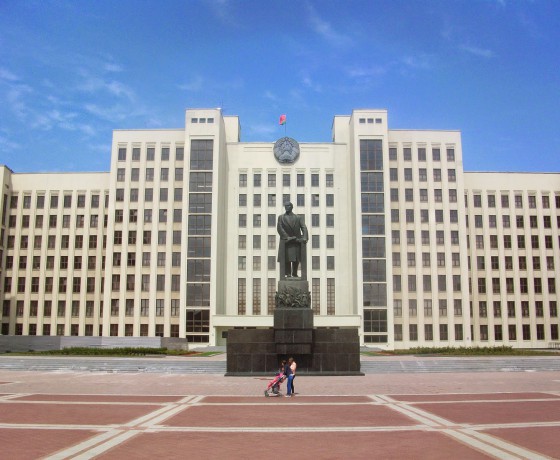Minsk
Situated on the Svislač and Niamiha rivers, from 1919-1991 it was the capital of the former Byelorussian Soviet Socialist Republic. The city was 80% destroyed during World War II and as such was rebuilt in the 1950s to the liking of Stalin. Large, Soviet-bloc style buildings make up a large portion of the city. For this reason, Minsk is a wonderful place to visit for those interested in the Soviet Union.
English is rarely spoken, and tourism is not a priority in Minsk. It would be wise to learn some key phrases in Russian (which is the default language), but Belarusian may also be spoken or understood).
More information on Wikitravel
After passing customs (first comes the visa office on the second floor, second – passports control, third – customs control), you will find yourself in one of the dim arrival halls on the ground level. Each of the two halls offers a currency exchange booth (only one of them functions – the one at sector 5-6, 24/7 but with lots of “technical breaks”), a newspaper kiosk sector 5-6, 3rd floor, and lots of private taxi drivers offering their services. ATMs are few and badly marked, but they do help in avoiding the queues at the exchange booths. Car rentals (Sixt and Europcar) are located at the sector 5-6, on the far left. Departure hall on the third floor is more bright and comfortable, with a 24/7 restaurant and few other places to eat (open 9—21), as well as a small souvenir shop, bank and post offices.
Upon departure, you have to go through a security control before you proceed to check-in. The area behind the check-in features several duty-free shops and bars. The whole terminal is covered by decent Wi-Fi from Beletelecom, but you have to purchase an access card (very cheap, though) at their office or at the newspaper kiosk in the departure hall before check-in.
Flight connections to Minsk are still somewhat scarce. Belavia operates regular flights to Moscow (6 times a day), Saint Petersburg and Kaliningrad (1-2 flights a day) as well as Tbilisi, Prague, Kiev, Tallinn and Riga. It also has flights to major European airports, but none of these destinations are served on an everyday basis. Alternatively, you can fly to Minsk with Aeroflot (Moscow, twice a day), Lufthansa (Frankfurt, 1-2 times a day), Austrian Airlines (Vienna, twice a day), LOT (Warsaw, once a day), and Aerosvit (Kiev, once a day). Although low-cost airlines do not serve Minsk, most of the available carriers offer cheap tickets every now and then. If you are unable to find a cheap ticket or a suitable connection, consider flying to Vilnius, Moscow, or Warsaw and travelling to Minsk by train. However, the overland travel may require an additional visa and generally causes more bother than the arrival by plane.
- By Bus
The airport is served by regular bus no. 300э running every 45-60 minutes from/to Centralny bus terminal, next to the main railway station (Minsk Pasažyrski). At Centralny bus terminal, tickets are sold at the ticket office. At the airport, they can be bought from the bus driver (BLR30,000 as of January 2014, cash only) or ticket machine by the main exit paid by cards. While getting in the bus, you may be asked to pay for luggage (other than hand luggage) around BLR4000. The only bus stop is in front of the arrivals on the ground floor.In about 30 minutes after leaving the airport, the bus stops at Uručča(Uruchye) subway station. Many passengers leave here to continue by subway and other means of public transport. If travelling to the airport from Uručča(Uruchye), leave the subway station through the front exit, turn right, and find the outermost bus stop. There is a small, well-hidden plate with a timetable.
If you travel to the Aŭtazavod area (Аўтазавод / Автозавод) – Mahilioŭskaja subway station – you may prefer taking bus 173э to Sokal (Сокал / Сокол) suburb and changing for 112с at the same bus stop.
- By Taxi
Taxi is the only alternative to the 300e bus option. There is no official taxi service, yet private drivers abound. The ride to the city centre should not cost more than €25—30, and bargaining is recommended. If you prefer official service, call a taxi from any company in the city and pay the same price.To reach the airport by car, leave the city by Niezaliežnasci (Nezavisimosti) Avenue and follow the M2 highway.






